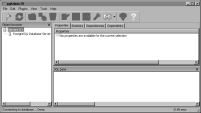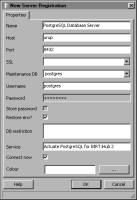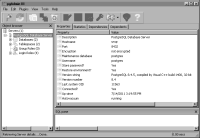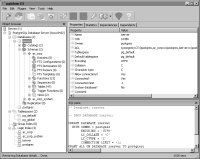Accessing the PostgreSQL Database Server using the pgAdmin utility
After migrating the Encyclopedia volume to iHub, you can optionally open the pgAdmin III utility and access the PostgreSQL Database Server to browse the Encyclopedia volume database. Actuate does not support modifying the BIRT iHub PostgreSQL Database schema. Any changes to the schema made by the customer, such as the addition of an index on a table, must be recreated again manually in any future upgrade.
How to access the PostgreSQL Database Server using the pgAdmin utility
To access the PostgreSQL server, choose Start➛Programs➛pgAdmin III 1.10➛pgAdmin III.
pgAdmin III appears, showing the PostgreSQL Database Server in the Object browser, as shown in
Figure 2‑25.
Figure 2‑25 Viewing pgAdmin III
If the PostgreSQL Database Server does not appear in the Object browser, you can add the server manually by performing the following tasks:
1 In pgAdmin III, choose File
➛Add Server. In New Server Registration—Properties, type or select the following property values, as listed in
Table 2‑1.
Table 2‑1 New server properties
Property | Value |
Name | PostgreSQL Database Server |
Host | <computer name> |
Port | 8432 |
Maintenance DB | postgres |
Username | postgres |
Password | <your superuser password> |
Store password | Not selected |
Restore env | Selected |
Service | Actuate PostgreSQL for BIRT iHub 2 |
Connect now | Selected |
New Server Registration—Properties appears, as shown in
Figure 2‑26.
Figure 2‑26 Registering a new server
Choose OK. Then, on pgAdmin III, expand PostgreSQL Database Server, as shown in
Figure 2‑27.
Figure 2‑27 Viewing PostgreSQL Database Server properties
2 In Object browser, expand Databases—iserver, iserver—Schemas, Tablespaces, and Login Roles to review the server and database installation, as shown in
Figure 2‑28.
Figure 2‑28 Browsing the PostgreSQL Database Server installation
The BIRT iHub uninstall process can optionally remove the iHub installation directory containing the encyc folder, which by default contains the postgres database directory. The uninstall process does not uninstall the pgAdmin III administration tool, a PostgreSQL database not residing in the AC_DATA_HOME/encyc directory, or another third-party database used to store the Encyclopedia volume data. You must uninstall these components separately.




